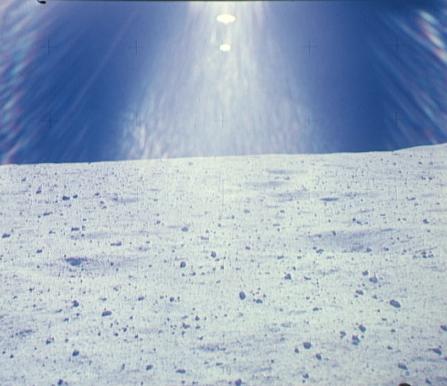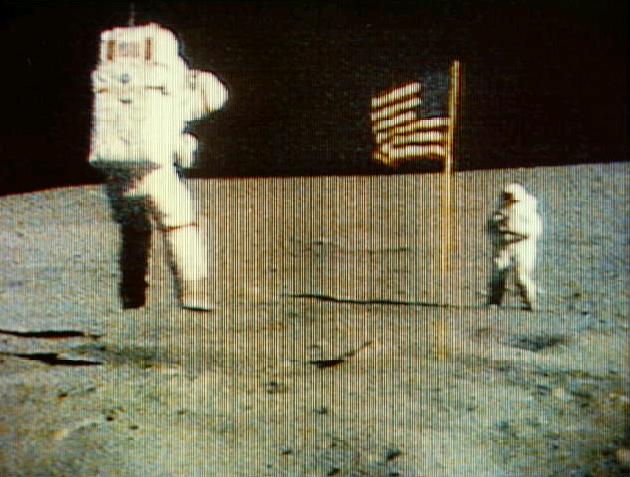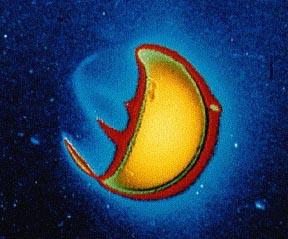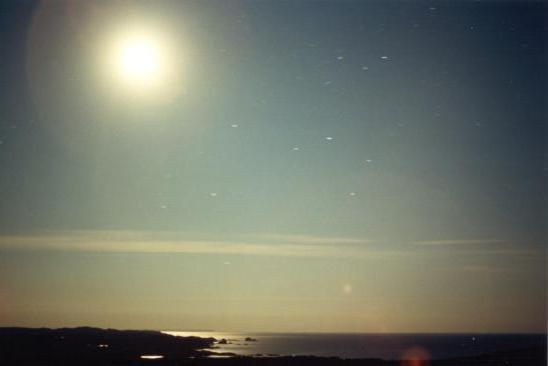Subj: LUNAR FANTASIES
Date: 01.09.2004First, cheers for your website.
I particularly appreciated the article LUNAR FANTASIES, it is true that I did not have the honor to go on the moon myself, and that I am a layman as regards photography; your article gave me convincing explanations.
However, there remains a question that I am always pondering (the answer is undoubtedly obvious for you): why does no star appear in the "lunar" sky?
Thanks in advance and keep going.
That, is a "classical" question and I did not answer it in my article on the Moon landing fantasies, because it was not part of the arguments advanced by Philippe Lheureux [French "moon landing hoax conspiracy" promoter] for his thesis which is that no American set foot on the Moon. Undoubtedly he knows that it would not make a good argument; it is however always still agitated by others, if only in this January 2004 during the broadcast of a "documentary" supposed to prove the moon landing hoax thesis on a German TV channel.
Whether day or night, on the moon, stars are visible when one looks up. The sky is always black on the Moon, because the sun has no atmosphere there to light. Nobody disputes that. But that does not have any importance here. The "conspirationists" say that since one does not see stars on the images taken on the Moon, it is "one more proof" that the US faked the moon landings, that no American set foot on the moon.
Here is why they are wrong.
Stars are very, very faint lights. They are absolutely not more brilliant on the moon than on the earth, they send the same amount of light towards both. They do not of flicker as seen from the moon, because there is no atmosphere there, transparent of course, but often agitated. You see them rather well with your eyes, because your eyes adapt to the darkness, they become literally hypersensitive to their faint lights, when you look at stars.
However, in photography, it is very difficult to get these faint luminous points on film, at the same time than the rest of the subject of your photograph. One can adjust the opening of the camera, one can let the light impress the film for a longer duration, granted, but that does not have the same effectiveness at all as the human eye, actually.
You can check this yourself during a starlit night on Earth. Take a picture of a friend with the starry sky in the background. You will not see the stars on the photograph. Then take a photograph of the stars alone. You will see them, on the photograph, if you have set up your camera to that effect. You will note however that your specific camera setup to get the stars is totally inappropriate to photograph anything else than the stars.
Cameras, on the Moon, were naturally always set up to photograph what happens on the Moon, the LM, rocks, craters, the astronauts, and not to photograph stars. Still image Cameras were loaded with Ektachrome 64 film for the color photographs and Panatomic X for the black and white photographs, these are films for very short exposure durations relevant to photographs of the surface of the moon, which is violently lit by the sun.
Below: it is not easy to take good pictures of the Moon's surface. The sun is dazzling during daytime, either the contrast between the sunlit dazzling surface and the black sky, or reflections over the sky portion of the images are a nuisance.
Credit: NASA JSC, reference: Apollo 16, AS16-20121864 photograph.

|
Images taken from the surface of the moon and showing stars are rather rare, but not non-existent. Of course, the "TV documentaries" and books which promote the idea of a conspiracy do not show you such pictures. On TV, particularly, you will see video footage, not photographs, whose quality is not particularly high if one refers to current standards. The weak definition (the number of points by lines and the number of lines) does simply not allow anything as small and faint as a star to be seen anyway.
Below, a frame extracted from a video transmitted to Earth from the moon. For a simple question of image definition, stars could not be seen in such images.

|
I now want to specify which are the photographs which show stars. At the time of the Apollo 16 mission, for example, John Young had a sky photograph mission, he was asked to take astronomy photographs. He was equipped with a particularly adapted camera, invented and conceived for this purpose by George Carruthers, functioning in the ultraviolet spectrum. It had to be placed in the shade of the LM. the camera was of course expressly set up so that stars and galaxies are seen on the photographs: ultrasensitive film, long exposure, and a fixed stand.
Below: One of the photographs taken by Apollo 16 from the surface of the moon, with a specially designed camera for scientific photography of the sky (Far UV Camera/Spectrograph). In the middle, the Earth, its side lit by the sun returns UV. On the non sunlit side, northern lights appear. Around the Earth, stars and galaxies are visible.

|
Actually, if you have some time, take your photographs albums. You will probably find some photographs which you took outside at night, on Earth, on which no stars are visible. However, you really were there, on planet Earth, and nobody will tell you that the lack of stars on your photographs proves that you faked these images in a Hollywood studio...
Go to http://images.google.com and search for "starry night", "nightsky", etc. See for yourself: you will find loads of paintings and drawings and textures of stars at night, inspired by the good capacity for night vision of the human eye. But where are the photographs showing a starry sky from the surface of the Earth? There is very little of that. If you can find one, notice the exposure conditions and other clues that this starry night photograph required some particular setup: it is far from obvious to get stars on a nighttime photograph with ordinary cameras.
Below: Image taken with 2at 10:00 P.M., showing stars. The large spot is the moon, not the sun. Exposure time: 10 minutes! A tripod is mandatory, special photographic film is required. The astronauts had cameras attached to the chest of their spacesuit, without tripod, and film which was suited for images of the moon surface, not for stars in the sky.

|
In the end, it is on the contrary we saw beautiful stars on the NASA moon surface photographs that some doubts should be raised on their authenticity; that would be a gross and revealing technical mistake...